| |
Snow -- such simple stuff, really: the marriage of a super-cooled water droplet and a speck of dust. More droplets join and freeze into place and a crystal is born. Mr. Webster defined it as "solid precipitation in the form of variously shaped white or translucent ice crystals originating in the upper atmosphere as frozen particles of water vapor." Had he been a snowsports enthusiast, I'm sure he would have had much more to say about the subject.
As this crystal descends towards earth, it changes with the temperature and moisture variations until it finally forms a snowflake. Flakes range from delicate needles to many-branched stars, with more than 5,000 different forms on record including stellars, dendrites, stars, columns, plates and needles. Snowfalls generally consist of a variety of these basic types of crystals.
| |
Images from Edward R. LaChapelle’s “Field Guide to Snow Crystals” |
|
What we envision as the classic snowflake ubiquitous in winter holiday décor -- a hexagonal star with delicate arms and points resembling lace -- is called a “stellar dendrite” and is the largest of snow crystals. The most common type of flake is an “irregular,” a small clump of crystals whose form cannot be deciphered, only greeted with joy by school children anticipating a Snow Day.
Regardless of their appearance and makeup when they land, snowflakes immediately begin to morph. Fresh, cold snow holds little moisture but has sharply pointed crystals, some of which interlock while others crush under their own weight. Due to the large amount of air in fresh snow (up to 90%), there is little cohesion and it doesn't pack well. As flakes settle, the sharp points tend to hook together and as they become denser and heavier, the bonding strength increases. Additional snowfall, temperature changes, wind and sun all produce a constant change in the snow pack, giving outdoor devotees a variety of snow conditions with which to contend.
| |
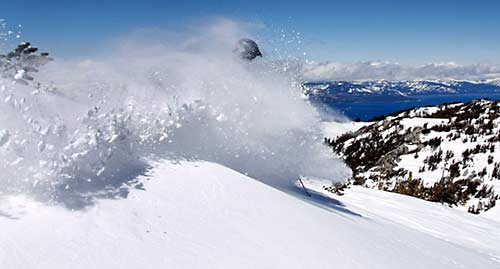 |
|
| |
“Powder” is the Holy Grail for snowsport fanatics. Low moisture content means the snow, mostly consisting of column and plate-type crystals, doesn’t compact and can create a condition known as “white smoke.” Keep your snorkel handy.
(photo by Dino Vournas) |
|
“Hardpack" results when crystals melt during the day, then refreeze overnight to create a solid layer. A deep freeze followed by a thaw produces a solid sheet of ice called "boilerplate." When wind drives water vapor into the surface of the snow, the moisture condenses and freezes into crystals at the surface resulting in "windpack." Depending upon the depth of this crust, snow travelers may walk or glide across the top, break through with every attempt to step or turn, or alternate between these two possibilities. “Crud,” often referred to on the West Coast as Cascade Concrete or Sierra Cement and other less printable monikers, is old snow, very heavy, unforgiving and is most often embellished with a sharp broken crust.
| |
Nature often sculpts snow into art forms. A dune-shaped drift is known as a “snow barchan" (photo by Dino Vournas), while "sastrugi" are long, wavelike ridges and grooves formed by the wind. |
|
Tiny, dry, pebble-like crystals are "frozen granular" which is dense, older snow that has lost its interlocking points. Alternate freezing and thawing produces “corn,” is similar to frozen granular except the sun melts it back into separate grains. With no points left to hook together, it creates a delightfully sugary effect second only to powder for a big fun factor.
| |
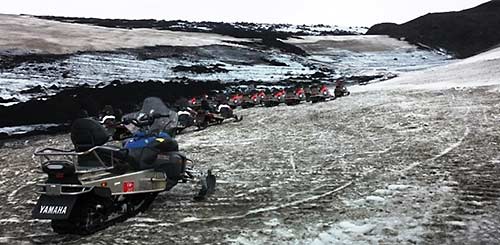 |
|
| |
There have been reports of red, yellow and even black snow falling, most likely the result of pollen, windblown dust or volcanic ash. The snow on Iceland’s Myrdalsjokull glacier is often colored by the volcanic ash from Eyjafjallajokull, less than 15 miles away. |
|
Snow isn’t actually white. A snow crystal’s surface is faceted which creates hundreds of tiny prisms which refract the light into all colors of the spectrum and reflect back to our eyes as white. If the snow is deep enough, the layers absorb more red than blue and can give it a blue hue. It can even appear pink in high alpine and coastal polar regions where a type of cold-loving red-pigmented fresh-water algae tints the snow.
Snowflakes can be huge. The world’s largest is said to have been a 15” wide by 8” thick flake that fell in Fort Keogh, Montana, in January 1887. Examples up to 6” wide have been reported in various places around the world, but it’s a myth that every snowflake is unique. While they always have six sides or points, they can have twins as proven by a scientist in 1988 who identified two identical flakes from the same Wisconsin storm. Don’t you wonder how many he had to scrutinize before he found a matching pair?
| |
Moisture-laden air coming in contact with colder surfaces such as trees or chairlift towers often leaves a feathery pattern known as “hoarfrost” or “rime.” Sometimes it builds up thick enough to create “snow ghost” trees like these lining the Coquihalla trail at Sun Peaks, British Columbia.
(photo above left by Dino Vournas) |
|
But swirly flakes aren’t the only way snow is delivered. If crystals fall through a freezing layer of damp atmosphere, ice may form on the outside of the snowflake to create snow pellets or “graupel.” While most snowfalls are mesmerizing to watch, “thundersnow” can be unsettling when ice crystals crash about in the clouds and create visible lighting in the midst of a blizzard.
Just because it’s snowing hard doesn’t mean it’s a blizzard. Winds must bluster at least 35 mph and snowfall reduce visibility to less than one-quarter mile for at least three hours before you have an official “blizzard;” otherwise it’s a “snowstorm.” If strong winds come and go it’s a “snow squall.” If a brief, windless snowfall leaves a dump of snow, it’s a “snowburst.”
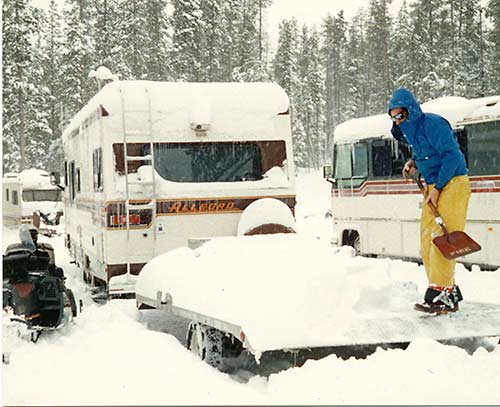
Head out for a 32-mile roundtrip snowmobile jaunt from Diamond Lake to Crater Lake
and a passing snowburst may leave your trailer buried. Keep your shovel handy.
Weathermen roughly equate one foot of rain to one foot of snow, but this depends greatly upon the moisture content. One inch of liquid sunshine can result in anything from five to fifty inches of snow. Water content may be as high as 15-20% in coastal mountains of the Pacific Northwest, or as low as 5-10% in the Rocky Mountains.
U.S. record for most snowfall in one year is held by Washington’s Mt. Baker Ski Area, whose whopping 1,140” (that’s 95 feet!) fell during the winter of 1998-99, also placing it at the top of the World Record for Snow Accumulation. U.S. positions #2 and #3 are held by Thompson Pass, Alaska, with 974” in 1952-53, while the winter of 1948-49 left 822” at Crater Lake National Park in Oregon.
Average snow accumulations pile up deeper in the Cascade Mountains of the Pacific Northwest than anywhere else in the U.S. with Mt. Baker again topping the list at 701” and nearby Mt. Rainer Paradise Ranger Station in second place with 671.” But if you want to really be wowed, in 2015 Capracotta, Italy, was buried under 100” in just 18 hours, a world record for the City with the Biggest Snowfall in One 24-Hour Period. Silver Lake, Colorado, has held that U.S. record since 1921 when nearly 76” fell, although the blizzard continued for 32.5 hours eventually leaving 95” behind, another record for the Most Flakes from One Continuous Snowfall.
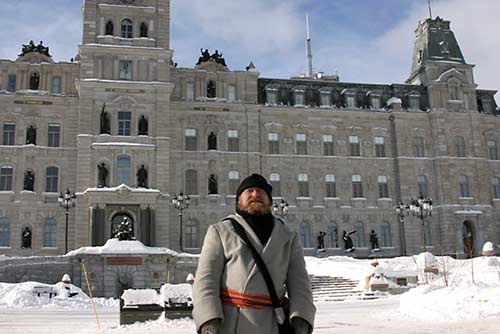
Quebec City’s Parliament Building shows off a dusting of snow.
An average 124” each year ties this Canadian capital with
Syracuse, New York,
as one of the snowiest cities on earth.
The U.S. is hit with just over 100 snow storms every winter, typically lasting 2-5 days. But the winter of 1991-92 was so severe, in March 1992 the City Council in Syracuse decreed it illegal for any more snow to fall until Christmas Eve. But Mother Nature doesn’t like to be bossed around - she covered the city again just two days later, and the following winter was even snowier.
Snow can fall in places you’d never imagine. Anywhere from a dusting to a couple of inches have graced Houston, Texas (1” in 2009, 0.7” in 2017, trace in 2018), Los Angeles (.03” in 1954), Tallahassee, Florida (1” in 1989, .01 in 2018), the Sonoran Desert (1.5” in 1932, dusting in 1967), and Antsirabe, Madagascar, where it covered the ground in 1900.
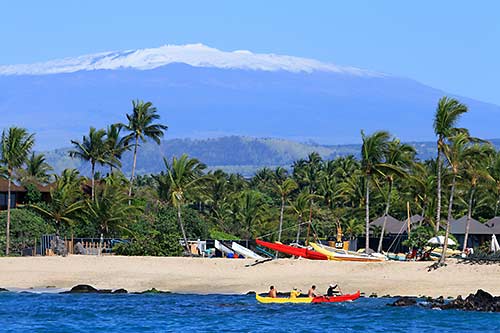
Better known for palm-studded beaches, world-class surfing and spewing volcanoes,
Hawaii Island is an almost annual recipient of snowfall. Mauna Kea,
whose name means
“White Mountain,” and Mauna Loa both top out over 13,000 feet
and can receive
up to
two feet at a time. Even Haleakala on nearby Maui gets a snowcap
every couple of years,
with near record snowfall and four-foot drifts in February 2019.
(photo by Kirk Lee Aeder, courtesy Hawaii Tourism Authority)
In a twist of irony, the Earth’s poles do not receive much snow. The ice-covered Arctic Ocean is surrounded by land which produces scant precipitation. Although ringed by ocean, Antarctica is in fact considered a desert. Cold air can’t hold much moisture so only about two inches of precipitation accumulates annually, but that’s enough to bury our southernmost continent under an ice sheet up to three miles thick and keep it covered for the last 40 million years.
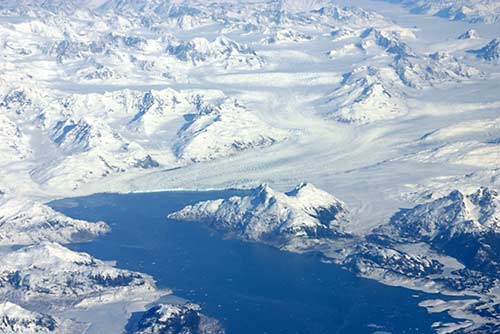
Around 100,000 glaciers cover nearly 28,000 square miles of Alaska,
including this one emptying into the Gulf of Alaska. At 118 miles,
the Bering Glacier is Alaska’s longest, terminating about 10 miles away.
Ice sheets, ice caps and glaciers cover nearly 6 million square miles or 10% of the Earth’s surface. Holding almost 70% of its fresh water, if they suddenly melted, sea levels would rise more than 200 feet. Created over countless millennia, glaciers form where snow never melts and each new snowfall compresses the accumulation beneath, making it more and more dense until it transforms into glacial ice. At 250 miles long, 60 miles wide and 1.5 miles thick, Antarctica’s Lambert-Fisher Glacier is the world’s biggest, while Washington State has the most glaciated land area in the Lower 48. Even Mount Kilimanjaro, barely 200 miles south of the equator, has glaciers, although like all the planet’s glaciers and ice sheets, it is rapidly shrinking.
A few facts and factoids about snow: Like a sparkling diamond or a translucent grain of salt, snow is also a mineral. It takes 180 billion molecules of water to create the average snowflake. The first person to photograph a snow crystal was “Snowflake” Bentley in 1885. Capturing specimens on black velvet, he used a bellows camera attached to a microscope to record over 5,000 amazing examples, after which he died of pneumonia. Insulated by the fresh, compacted snow from which it’s made, then warmed by its occupants’ body heat, an igloo can be over 100 degrees toastier inside than outside. A fear of or severe aversion to snow is called Chionophobia. Pibloktoq is the term for the cold, snow and darkness actually driving someone crazy, first documented among but not limited to the Inuit people. Google “baby names for snow” and you’ll find over five dozen ways to name your little one after your favorite winter outdoor adornment.
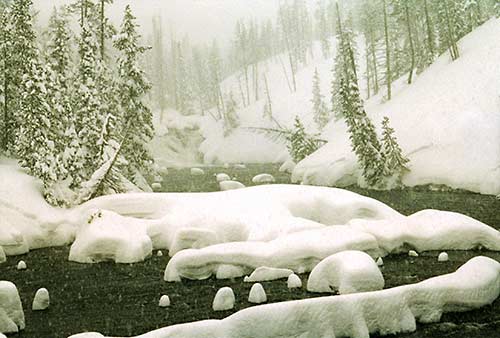
Snow pillows on the Lewis River, Yellowstone, Montana.
With Snow and its harbinger, Winter, holding sway for months on end, myths and legends about them have arisen around the world. Some folklore says supernatural creatures only reveal themselves when it’s cold. In Norse mythology, Ullr and Skadi are the God and Goddess of Snow and Mountains with Ullr deemed the Patron Saint of Skiers. Germanic tradition says snow is created by the goddess Holda shaking her feather bed. In Gaelic legend, Beira, also known as Cailleach Bheur, is the Goddess of Winter and her clean laundry creates a white blanket of snow.
Old Man Frost is a legendary Slavic character who is accompanied by the beautiful and ever-young Snegurochka, the Snow Maiden. A Japanese woman who dies from the cold becomes a yukionna, an entity who appears on snowy nights floating above the ground with her magical powers, sometimes transforming into snow itself. And beware the oshiroi baba or Snow Hags of Japan who come down from the mountains in winter, their faces covered in white.
Native American tribes included winter gods in their pantheon: Flint (Iroquois), Shakok (Pueblo) and Windigo (Ojibwa). The Aztecs personified cold and winter in their death god Itztlacoliuhqui. The Maori called their winter goddess Hine-Takurua, while the Hawaiian Snow Goddess Poliahu, sister of the Polynesian Fire Goddess Pele, is believed to reside on Mauna Kea. Iranian folklore tells of Nane Sarma or Grandma Frost.
The Greeks and Romans had deities who personified nearly everything, snow and winter no exception. Boreas, the Greek God of Winter and the Cold North Wind, lends his name to the term “boreal” meaning a climate with long winters or a subarctic ecosystem. From his daughter Chione, the Goddess of Snow, we derive Chionophobia, the fear of snow. Kheimon was the Greek Goddess of Winter, and the Romans hailed Hiems as their Winter God.
Another creature associated with snow is the abominable snowman aka yeti, aka bigfoot, aka many other monikers around the world. Linked in particular with the Himalaya Mountains, to the people of Tibet and Nepal, the Yeti is a sacred guardian of the mountains and soaring snowy realms.
It is commonly repeated that “the Eskimos have 50 words for snow,” which isn’t quite true. The Inuit (the accurate name for “Eskimos”) have hundreds of words to define various characteristics and subtleties of snow. Siqoq is drifting snow, aniu is falling snow, upsik is wind-whipped snow, siqoqtoaq is crusty melting frozen snow, saluma roaq is fine smooth snow ... you get the gist.
| |
The ways to enjoy winter’s bounty are limitless. It can be a leisurely snowshoe through the forests of Idaho, blasting powder in the Chugach Mountains near Valdez, Alaska, or pedaling along a hardpack single-track. Building a snowman or staring out the window also count.
(Images above left and right courtesy of McCall, Idaho) |
|
Folks who love winter escapades eagerly tune in to weather reports and are downright giddy to find the freezing level is falling and moisture is heading toward their favorite playgrounds. But it doesn’t take a lively outdoor pursuit to enjoy the pleasures of snow. Is there any sight more calming than snowflakes fluttering earthward? They muffle and soften the sounds around you. They blanket everything with an indescribably fresh aroma. They have no taste but leave a light tingle when you capture a flake on the tip of your tongue.
Find your own special way to soak up the magical splendor of those "frozen particles of water vapor” that have arrived.
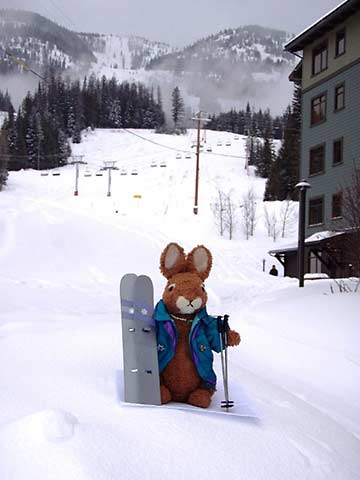
Truffles finds her own Snow Magic
|
|